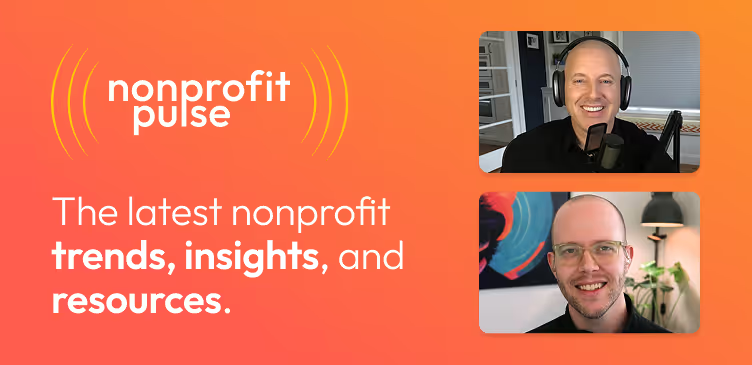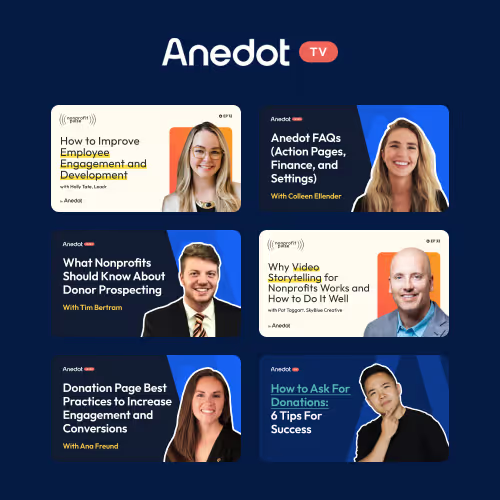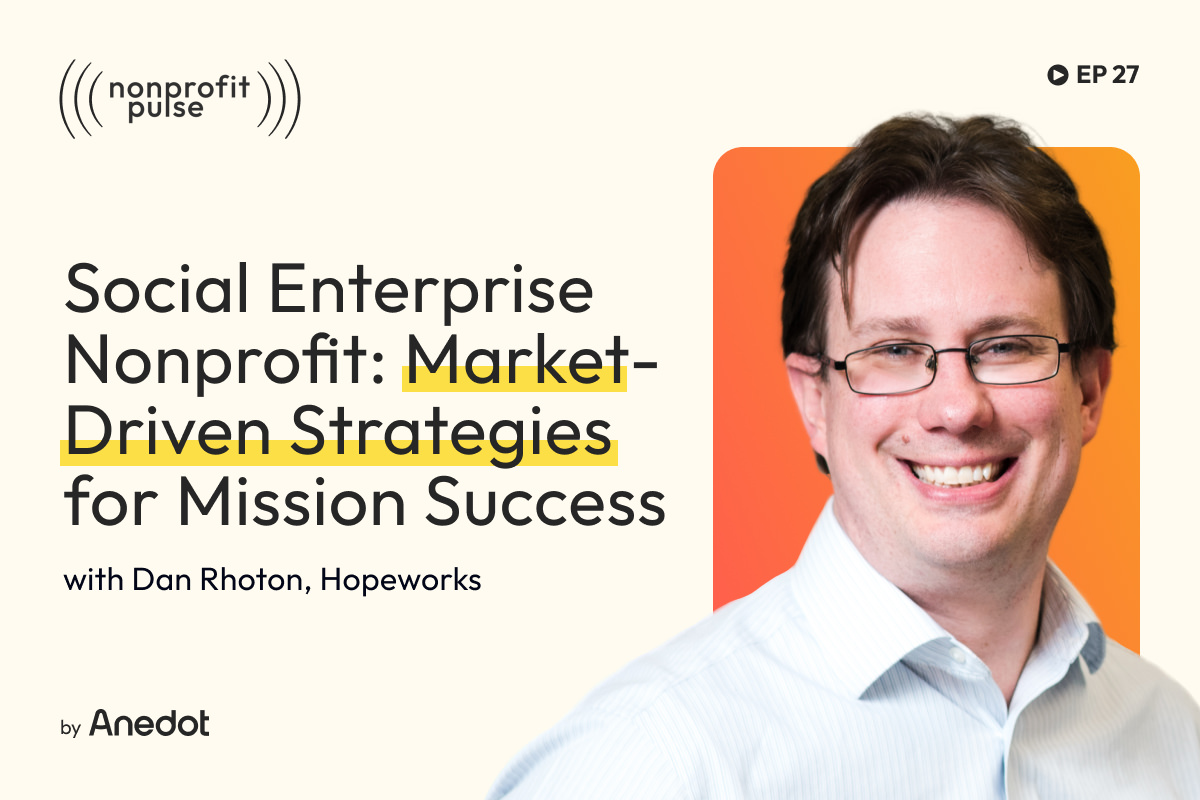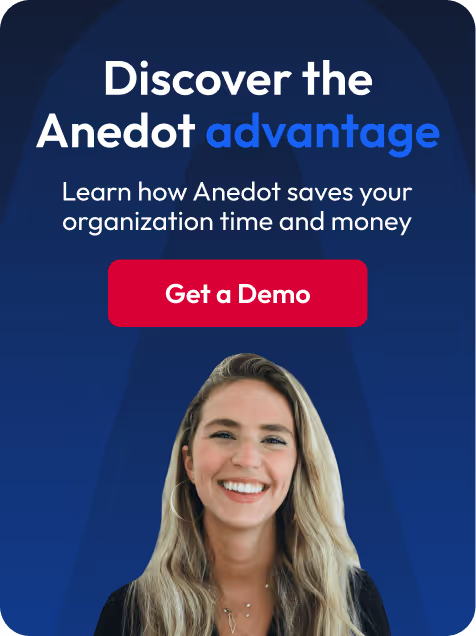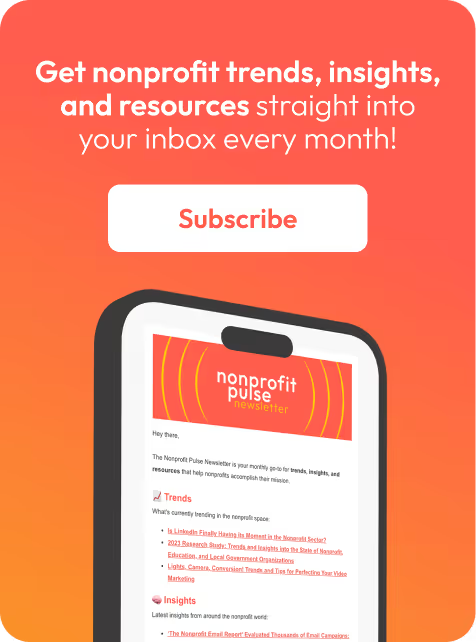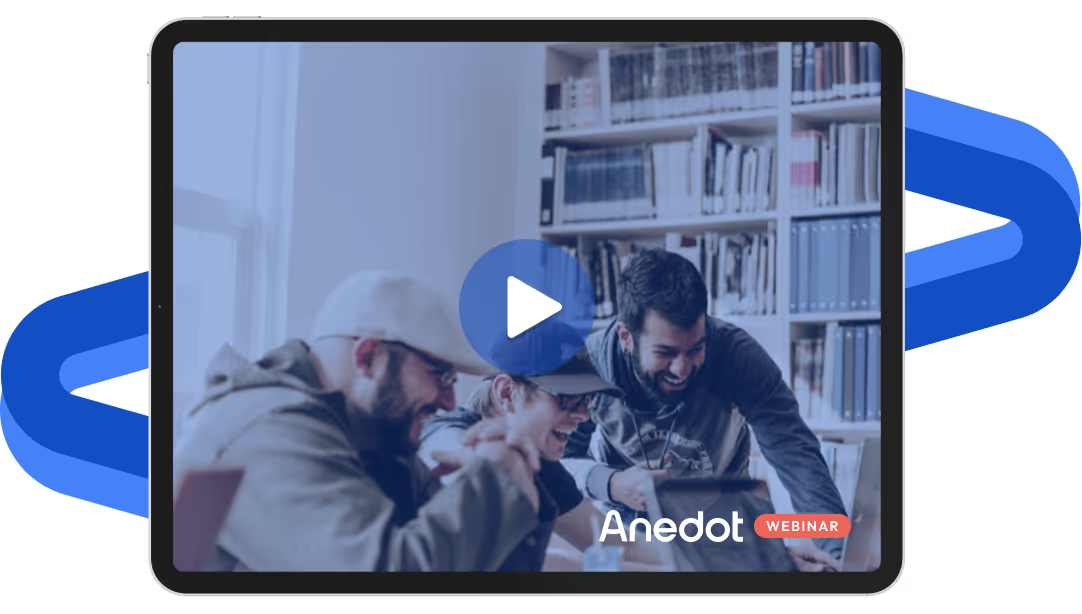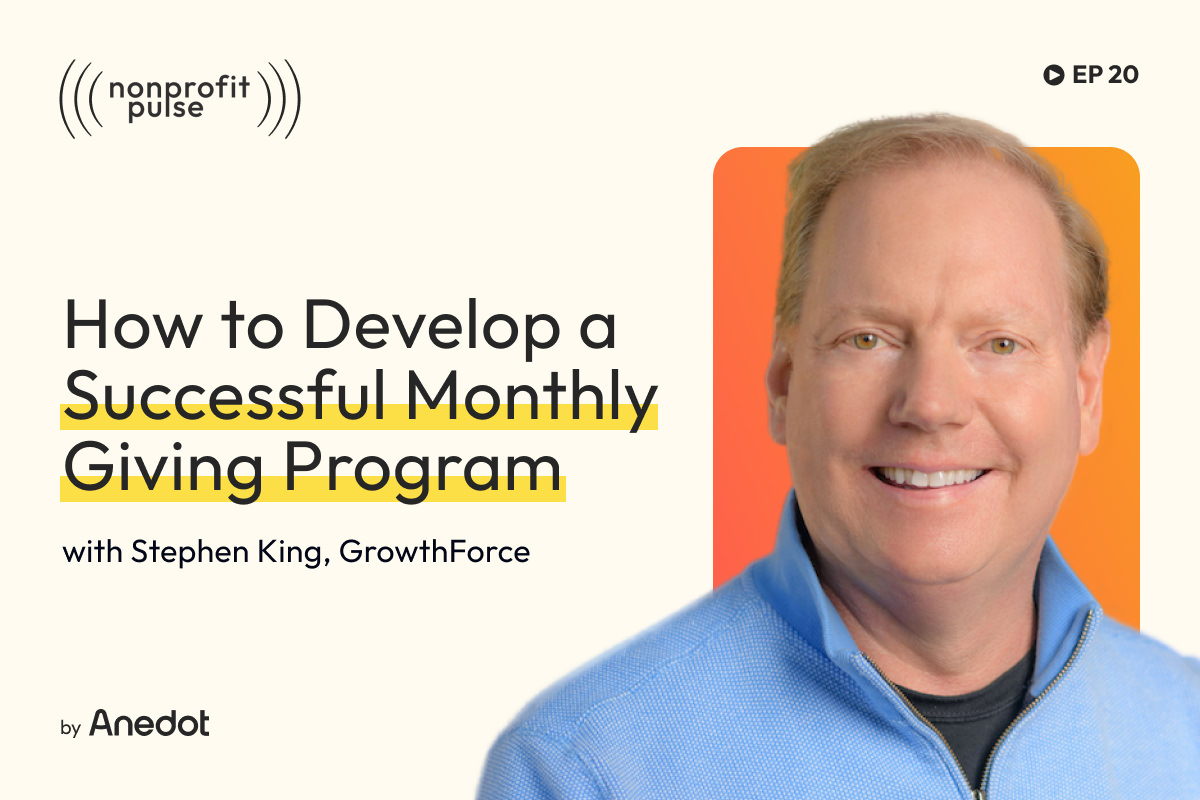Podcast episode transcript ↓
Josh:
Some nonprofits go beyond relying on donations and grants by generating their own revenue while still driving meaningful social change.
Social enterprise nonprofits blend business strategies with social impact, creating a sustainable approach to mission-driven work.
But balancing financial sustainability with a nonprofit mission isn’t easy.
How do these organizations navigate the unique operational challenges they face? And what market-based approaches help them maximize both revenue and impact?
I’m Josh with Anedot, and welcome to Nonprofit Pulse where we explore trends, insights, and resources that help nonprofits accomplish their mission.
On this episode, we are joined by Dan Rhoton on the topic of social enterprise nonprofit operations.
Dan is the CEO of Hopeworks, an organization that helps propel young adults into long-term living wage careers that put them on the path for healing and financial stability.
Dan has been working with youth for the past two decades in various capacities, working as a teacher, school administrator, and organizational leader.
Over the years, Dan has been recognized numerous times for his work with young adults, most recently in 2022, being named one of Philadelphia's “Most Admired CEOs.”
Hey, Dan, thanks for joining us on Nonprofit Pulse.
Dan:
It's a pleasure to be here. Really excited to chat today.
Understanding social enterprise nonprofits and how they differ from traditional nonprofits

Josh:
Excited for our conversation.
We're talking operations of a social enterprise nonprofit and really exploring what is a social enterprise nonprofit, how do you measure success, challenges, how to overcome those challenges.
So maybe first starting off, Dan, if you could just define social enterprise nonprofit for the uninitiated out there, which I think I would include myself in that group.
How would you define a social enterprise nonprofit? And really, how does it differ from more of a traditional nonprofit?
Dan:
Yep. So a lot of ways you can get fancy and get confused about that.
All a social enterprise nonprofit is it's a nonprofit that has a mission, and it uses market based business and market tools to solve the social mission.
So a traditional nonprofit, hey, they're doing donations and providing services. That's great.
What a social enterprise nonprofit does is it uses the market based forces of business, enterprise, and capitalist market forces to accentuate and accelerate its mission.
Navigating operational challenges in social enterprise nonprofits

Josh:
Yeah, so thinking about kind of the operational challenges that may be unique to a social enterprise nonprofit, what would you share, the challenges y’all face and you've noticed peers are facing as well?
Dan:
You know, one of the biggest challenges as a social enterprise nonprofit is are we keeping our promises?
So at Hopeworks, we move young adults from employment to full time living wage jobs, right? And we do that by running technology businesses.
That means we have all the problems of running a technology business.
We got to deliver for clients. We got to do great work. We got to make sure it's profitable.
But at the same time, because of our mission, we are deliberately working with young adults, workers that are not great at their jobs at first, right? They’re entry level employees.
And the way our mission works, we’re an employment social enterprise, which means we train young adults to work for us and the moment they start getting really good, the moment they start becoming really profitable for the company, we give them to someone else, right?
We're moving them up to permanent employment.
So there's always a tension between the way to run a business, right, which maximizes profit, maximizes efficiency, and changing people's lives, which often is in conflict with the market based force.
So you kind of always balance those two.
Josh:
Yeah. And thinking about kind of the dual challenges of generating revenue as a nonprofit and then also driving social impact, how do you balance that?
Maybe at Hopeworks, your organization, or even just more broadly for other nonprofits out there, how do you balance that need? Those dual challenges there?
Dan:
So you don't. You have one thing that you do, which is at Hopeworks, we're going to move folks into living wage jobs, right? That's what we're going to do.
Then where everything else that we do is going to be subordinate to that. And I think that's really important for us is that as a nonprofit, we are asked to do a million things.
But you really can only do 1 or 2 things well as a business, right?
So often times I hear nonprofit professionals talk about juggling priorities or dealing with the desires of donors or clients.
That means you're doing it wrong.
As a nonprofit, you have one thing to do, which is deliver for your clients.
If you have a donor or a funder that is making it difficult to do that, you need to decline his dollars, which I understand can be hard, but it's going to pay off.
If your social enterprise business is placing demands on you, that's going to act in a way that's not going to allow you to deliver for your young adults or your clients, you've got to change your business model, right?
One thing we always say is, if you find yourself talking about juggling priorities, that means you need to reorder that priority list.
Josh:
Love that. And I'm familiar with an organization up in Indianapolis called, Purposeful Design, which is kind of a very similar organization where they take folks who need a leg up, they need assistance, they need stability.
And they give them a job to do, and they build just incredibly, beautiful furniture. And they really create craftsman out of these folks.
It just makes me think of like the impact that each dollar can have in supporting y'all as you're rebooting a lot of people's lives and helping them have an impact in their communities and just even in their own families.
Effective market-based approaches for nonprofit success

Josh:
So switching gears over to the market based techniques that you found most effective for your nonprofit, maybe others.
What would you share around that? Because I think that's a unique concept to a lot of people.
Dan:
Yep. So how we work at Hopeworks is we train young adults in technology and workforce skills, but then they work for us, building websites for companies all over the country, doing GIS, and data analytics for Fortune 1000 infrastructure companies.
And that's what we do. And then we train them. We get them work ready, they work for us, build a portfolio of work, and then we move them on into living wage jobs.
What we found, and probably the best thing that's important is, number one, do not compete on social mission.
And we've learned that the hard way. If we're going for an RFP, if we’re going for a contract and we share about our social mission early, we will lose the contract and get a donation.
If instead we are competing for RFP and we win the RFP and then talk about our social mission, we will get the contract and the donation, right?
What we found is when you are talking about social mission too early in the sales process, folks perceive your company as being not capable of doing professional work because they view this.
Whereas if you close the contract, you win on merits because you're awesome.
And then say, by the way, your dollars are going to go to there. It fundamentally changes the relationship.
And we also find that when you can, one of the best moments we've had is we had an employer call us and say, look, I want to start hiring your young adults.
I'm going to start hiring them. We're like, great, we haven't heard from you. I really need to hire them.
Great, we haven't built a relationship with you.
Why do you want to hire our folks? He’s like, I know I want them. Of course you do, but why?
He said, well, truthfully, you beat me on my last three contract bids.
And that’s the difference, right, is, number one, running as a social enterprise, you got to win on merit.
You got to run a good business. Then the social impact is the icing on the cake.
But it can never be your leap. Either you're not going to get the project, or you're going to get what we call a pity project, right?
Oh, let's throw this a little bit of work. We don't really expect that to happen. That's no way to grow your business.
Josh:
Yeah. And it makes me think of that concept of charity.
Like, if you need a service done or you want a product, whether it's a service that you're providing at Hopeworks or a product like I mentioned at Purposeful Design, you want that to be a great product.
You have needs that need to be met. You've been entrusted with the budget to have those needs met.
And when you bring that word kind of a charity, IT work, or a charity web services work, it does have a different flavor to it.
It does almost not engender quality or trust. Kind of at the front end of the conversation.
Dan:
Yep. And you know, the other thing I'll add, Josh, is that it also tells everyone around you that you believe that your participants are less than.
Whereas when I say to a client, like, bring it on, not only are we going to bid for this RFP, we're going to beat you.
The clear impression, which is accurate, is our young adults are awesome. They're well trained, they're ready, they're professional.
And they're going to beat the pants off you, which, by the way, means that you should hire them. I'm telling you that my participants add value and are incredible.
When I lead with, oh, well, our folks have had a lot of struggles and I hope you'll give us a chance.
The message is clear. Not only do I not value my participants, but you shouldn't either, right? And they're not going to get the same level jobs.
They're not going to get paid well. And yeah, that tells as a client, a lot about what you really think about the folks you're working with.
Measuring success in social enterprise nonprofits vs. standard business metrics

Josh:
Thinking about measuring success in a social enterprise nonprofit, Dan, how do you go about that at Hopeworks?
And what would you share with our audience? And really, how does it differ from standard business metrics in light of y’all having that business side to your organization?
Dan:
Yep. So the first and only metric is are you keeping the promise that you made to all your participants?
At Hopeworks, we say, if you come in and do what we ask you to do, you're going to get a full time living wage job.
Right now, we're running at 96%. 96% of the folks that come in and do that with us are placed. That is the only metric that's important, right?
Once you have that metric identified and you're hitting that number, all the other metrics are about efficiency.
But how can we do that faster? How can we do more of it better? And the last metric then is mission alignment.
So at Hopeworks, for example, we are dedicated to solving poverty, right?
What that means is there is no filter for admissions. If a young adult wants to change their life, we're ready for them.
So that means, though, when we’re running businesses, we want to place as many folks as possible in jobs, we want to do at a very high success rate.
We have a 93% 12 month retention rate in jobs, and we have to track wages at intake.
The reason that's important is because we can be running a great business. We could be doing it efficiently.
But guess what? The best way to run a business really efficiently is to stop working with folks with barriers, is to stop letting in folks that have struggles.
And especially as our reputation grows, we get folks who want to come to us not because have barriers, but just because they hear it's a great experience.
But then we got to have a metric to track. Are we really letting in folks that are experiencing poverty, or are we just letting in the folks that come to the front door that are easy to work with?
So the three things are first, are you hitting the mission? Second, are you doing it efficiently? And third, are you maintaining your dedication to the mission?
Josh:
Yeah. And how have y'all, kind of set new goals and new targets for those areas? Have y'all had a year over year goal?
Is it something more, shorter time frame, like a month over month?
How do you all view kind of time frames and goals inside of your metrics?
Dan:
Yep. So we start each year with how many folks are we going to place in jobs and what is the average wage and the 12 month retention rate going to be?
The entire budget for the whole organization is built off of that number. That number tells me how many coaches I need, how much revenue my social enterprises need to generate, how many training staff I need.
It's all built off of that number. I plug that number in the spreadsheet. It tells me everything else. Then I know all my other KPIs are weekly and they're based off of that number.
So if we're going to place 250 folks in jobs, then I know how many folks I need to place every week. I know how many folks I need to place every month.
And I know and I can track against that.
We have a report that comes out every Monday morning for every person on the team with their KPIs and how they're contributing to that, and if they’re missing it, it turns red.
And that's one of the best things about a social enterprise is because, listen, traditional nonprofit tries hard, but often, too often, too many nonprofits try hard, but all they really end up doing is making good excuses about why they couldn't achieve that goal.
Oh, we said we'd get folks jobs. But you don't understand how difficult it is.
What I love about working with social enterprises, we got KPIs, we got metrics. We either hit them or you don't.
Because the fact is, if we're going to solve poverty, we need to do it at speed and with efficiency. And so that's it.
So for example we're tracking how many jobs per week? What's the average salary?
Then we're tracking the coaches. What percentage of the coaches met with all of their case load?
Was it 90%? Was it 80%? Because we know, if you meet with your folks on their case load that's very predictive of them being successful on the job, right?
So we know our overall metric and then we know what we got to do each week and each month to hit that metric. And then we just track to it.
Josh:
And when things are going maybe sideways, for your metrics as you're tracking them, what does that reaction look like? Is that an all hands?
Is it, hey, we're watching this. We're going to watch it again and see if it happens again? What does that look like?
Dan:
Yep. So the nice thing is they always go sideways. Like that's the point of having KPIs, right?
Like if everything was going swimmingly, either that means that, A, you're not working hard, you're not challenging yourself.
You could be doing more or you chose the wrong KPIs, right? If this was an easy problem to solve.
So every week something's in the yellow, something's in the red. And what you got to do is you address it that week.
You address it immediately. Because what you know is this is not making flashlights.
It's not making wrenches. These are people's lives.
If one metric is in the red, that’s somebody who's not going to have a place to stay at the end of this. And you learn quickly.
One thing that is really important for us is we don't have a vision for how we're going to get folks in jobs.
All we have is data, right? So if we go through and someone doesn't get a job, why didn't they get a job? What do we need to change so that doesn't happen again.
That's how our program has grown and developed, right? If someone came in tomorrow and could prove to us that standing on our heads would achieve 100% unemployment, we'd start standing on our hands.
And that's the key, right? You got to deal with it immediately.
Why effectiveness matters more than innovation

Josh:
So switching gears a bit, I want to talk about innovation.
And really what role does innovation play in the operations of an organization like yours, a social enterprise nonprofit.
And how do you personally encourage innovation inside of Hopeworks?
Dan:
Yeah. So, I'll say something that some folks disagree with.
I don't care about innovation. I care about effectiveness.
So if we're hitting our targets and you're doing it this boring way that has been done before, let's keep doing it that way.
Now I'm going to play a game on you, though. If you're hitting your targets, I'm going to escalate the target.
That means we could do more, right? At some point, you're going to need to innovate and do something different to achieve that higher target.
Innovate, test, and iterate. Come up with an idea. Do a pilot with a small group. Do it quickly. If it works, let's scale it. If it doesn't work, throw it away.
But the fact is, what we know is, what I often say is if I'm trying to get from here to New York, right?
And I only have 90 minutes to do it, do I want to take the most innovative form of transportation, or do I want to take the most effective form of transportation?
Josh:
That's right, that's right.
Dan:
Yeah. So that's how we approach it.
Innovation is a way to get to your edge case and do more better.
But it is not a way to run your everyday operations. Especially when you’re dealing with people's lives.
How to create mutually beneficial partnerships with for-profit businesses

Josh:
Thinking about collaborations Dan, and in partnerships, an area we like to talk about on Nonprofit Pulse as we interview nonprofit leaders, how do you manage partnerships and collaborations with for profit businesses at Hopeworks?
And really, what are the key factors that really ensure mutual benefit when entering into those partnerships and collaborations?
Dan:
Yeah. So that's the first thing is goodwill is a nice way to start a meeting, but it's no way to build a partnership.
And so what we find is what you're looking for is mutual benefit. Because what is the company going to get out of it, and what are we going to get out of it?
That means that partnership, when you can identify that and clearly articulate it in the MOU, it can't be unspoken.
It can't be unsaid, right? It needs to be there and there need to be metrics. They need to be able to prove to us that they're delivering on what we would get.
And we need to be able to show to them that we're delivering what we said they would get.
When you do that, you don't have to worry about staff turnover.
You don't have to worry about, oh, I built this relationship and now they left because the company understands the value and you can keep moving.
Same thing for us, right?
We don't have to have someone ask why are you partnering with them? Or oh, you're only partnering with that company because they give you money or because you guys have a good relationship.
Nope. You can see the value.
And the other nice thing about that is when it's clear and articulate and you're tracking it, then you can grow it too.
You can go back and say, hey partner A, we had a great year. What would it look like if we doubled this? What would it take? How could we innovate to get there?
And then you can go. It doesn't just be kind of a routine thing where they volunteer once a year or you share each other’s social media posts.
The last thing that we see is then when you have that kind of partnership, you can grow it, you can scale it and you can recognize the folks that deserve it.
All too often when you're looking at a company, there's one or two folks who are your key advocates, right? They’re the key folks who make it happen.
And if you're not tracking the results of that partnership, it gets no recognition inside the company.
Whereas if we can say to the company, look, Chris worked with us for the last two years.
As a result of the partnership, your social media hits have gone up X amount, your employee engagement has gone up Y amount, and your employee retention has gone up Z amount.
You should give that dude a promotion and they will. And that's going to submit a partnership.
Closing thoughts

Josh:
I love that, I love that. And on this podcast Dan, we explore trends, insights, and resources that help nonprofits accomplish their mission.
So I'm excited to always ask about trends and what people are seeing kind of out in the field, in their areas of expertise.
So thinking about trends, what trends are you seeing in the social enterprise nonprofit space?
Dan:
Yeah, one of the most encouraging trends we're seeing is that folks are losing patience with non living wage jobs in the social enterprise trend.
And what I mean by that is all too often in a lot of social enterprises folks would do things like food service or which is great, but often the wages for those jobs are really low level, right?
Transparently, you would have folks who say, oh, we're going to have to train folks in jobs that seem appropriate for folks who, you know, black and brown young adults, for example.
And so they get stuck in these low wage culinary arts or other jobs. There's this really encouraging trend where folks are like, nope, we can do better, right?
Our young adults can do better. And by the way, more and more companies are recognizing that you could hire someone who's really effective and skilled, or you can hire someone who has the right degree.
And those two things often do not intersect, right? Companies are finally waking up to that reality, which is hugely beneficial.
Folks are realizing that having the right pedigree or having the right college degree has put us in this situation we’re in where folks feel like people don't want to work.
We have employers constantly crying about how there's no good workers out there.
The fact is, there's tons of good workers. They just got to stop looking at the same tired old pipelines they've always been using.
Places like Hopeworks and other social enterprises, we got the workers. We're ready for them.
Josh:
Yeah. So interesting. I saw an article earlier today communicating exactly what you just mentioned. And even across industries, across the country.
The article I read this morning was talking about UC Berkeley grads, computer science grads who even with 4.0 GPAs are not getting job offers upon graduation.
And, I say that just to say that I think a lot of organizations, a lot of businesses are realizing exactly what you said, that a degree is definitely a big achievement.
And, and it means something, but it may not mean as much as it has in the past, especially when it comes down to when the rubber meets the road, so to speak, when you need someone to get in there and do the job and do well and execute.
Dan:
And that's exactly it. I mean, you know, I think I speak for maybe a lot of your listeners.
When's the last time you used differential calculus, right, to deliver that product for a client?
No, I haven't, but when was the last time you had to use your emotional intelligence, your social skills, your grit and your resilience to make sure a project gets over the finish line?
Those are skills you don't learn from an elite college. You certainly learn them when you come up on the streets and doing everything by yourself.
So not only, well I’ll say, are our Hopeworks folks, as good as a college graduate from Columbia, I'm going to tell you that my guy, my person is probably better.
Josh:
Thinking of resources Dan, what resources would you recommend to our audience on social enterprise nonprofits?
Dan:
So what I would say one of the best things you could do is join businesses associations that have nothing to do with nonprofits.
Get away from your nonprofit peers.
Love them, right? Come back to them when you need a little homie thing.
But the fact is, you're not going to learn very much from folks who are doing exactly the same thing that you're doing, and especially in the nonprofit sector as a whole, generally is not very innovative, right?
It's not doing a lot always, right? Get away from them. Join the Chamber of Commerce, go to those meetings.
Go to the workshops by the Entrepreneurs Association, Vistage, go to those places where entrepreneurs are coming together to build something.
You'll learn something. You'll see that for profit companies are just as confused as you are some days.
Which can feel great. And you're going to meet people that you haven't yet met. And so get away from the old nonprofit thing.
Make yourself uncomfortable. Go into spaces that nonprofits are not supposed to be in. You'll be welcomed, and you'll learn a lot.
Josh:
Yeah, and it makes me think to you'll stand out.
I mean, I can imagine, Dan, if you were at a business conference where there are local or regional national, whatever that you would be known as, oh, that's Dan the guy with the social enterprise nonprofit.
That's who that is versus one of many in the sea.
Dan:
That's exactly right. I mean, you go to a nonprofit conference, you're one of a hundred of all, that feels all the same.
When we go to a technology conference, everybody wants to talk to us. It is such a better experience for our young adults. It's such a better experience for us.
And frankly, we get a lot more value out of the information presented too.
Josh:
Love that, love that. And I've loved our conversation.
So last question of the episode, Dan, at the end of every episode, I ask if you are standing on stage in front of a thousand nonprofit leaders and can share one thing with them, one sentence, what would you say?
Dan:
Go faster.
Nonprofit is the only industry where your efficiency and speed determines the course of people's lives. Stop planning, start experimenting, and track your data. We do not need another strategic plan in this nonprofit industry. We need folks out there getting it done. Because we got folks, too many folks, whose lives need changing.
Stop looking at your navel. Stop imagining what the world would be like if we solved all our social ills. And get out there, and get to work.
Josh:
Love it, love it. As always, for our listeners, you can visit Nonprofitpulse.com and find links to Dan's LinkedIn, as well as Hopeworks and other resources as well.
So, again, Dan, thanks so much for joining us in the podcast. Have loved the conversation.
And thanks for educating me and all of our audience today on social enterprise nonprofits and really just the operations behind them.
Dan:
Really fun to talk today. Thanks for making the time.
Josh:
Hey, thanks for listening.
If you enjoyed this conversation, please share or leave us a rating and review wherever you listen to podcasts.
Also, head on over to Nonprofitpulse.com to sign up for our monthly newsletter, as well as check out all the links and resources in the show notes. We’ll see you next time.
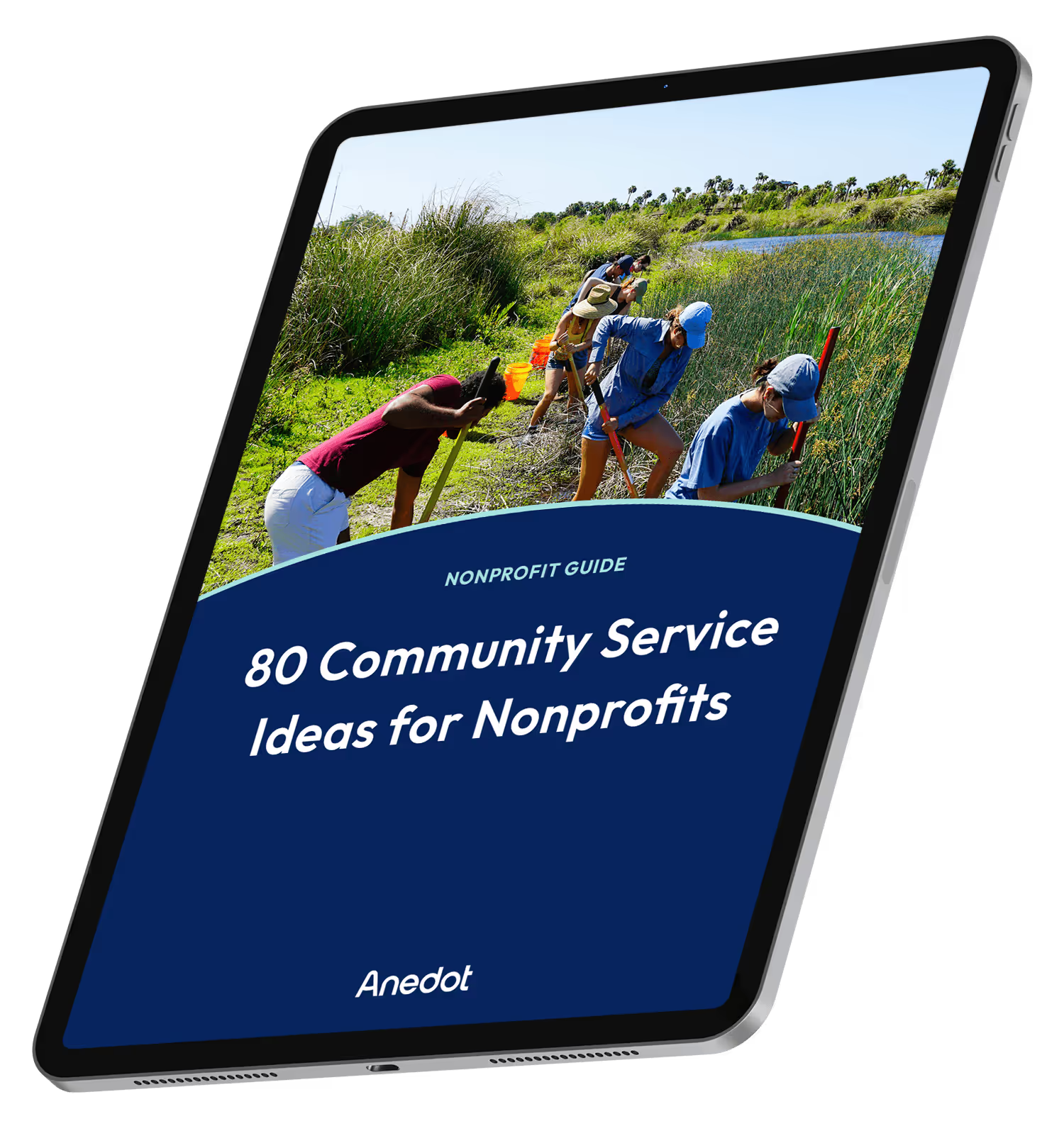
80 Community Service Ideas for Nonprofits

